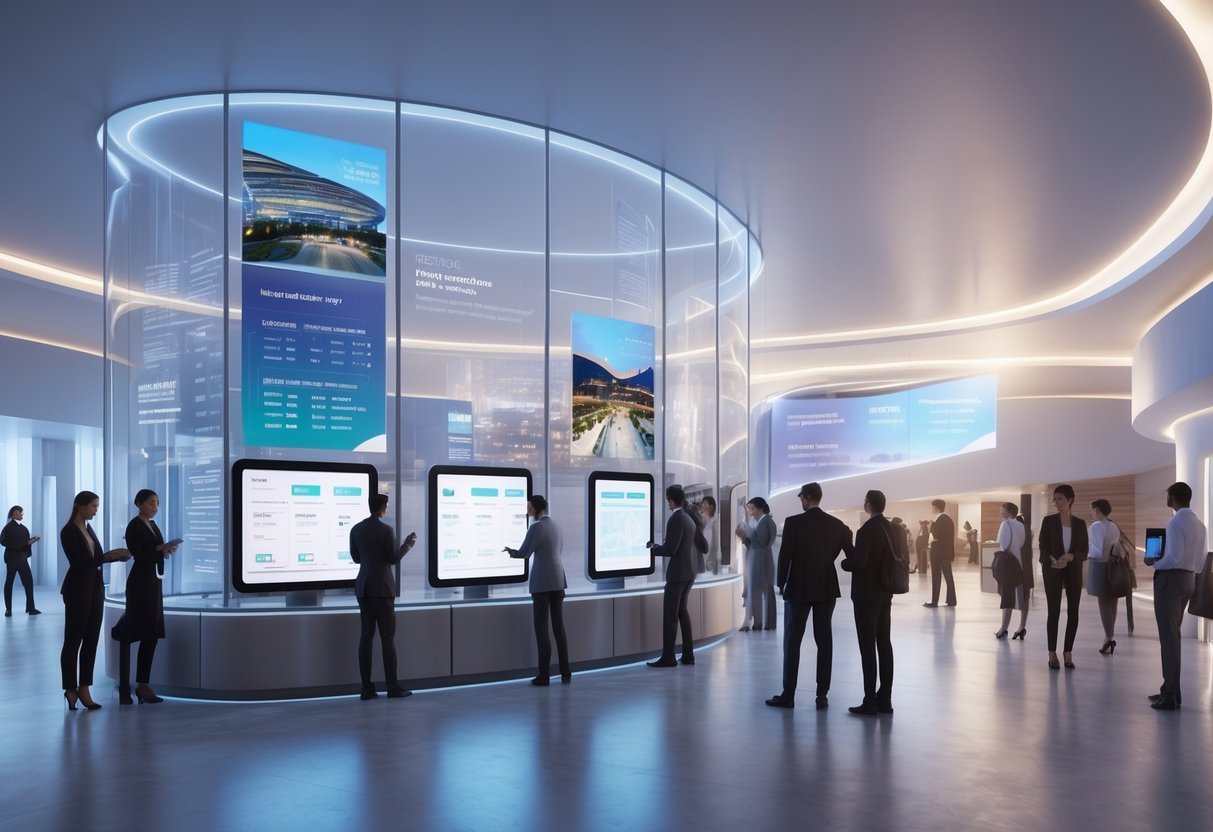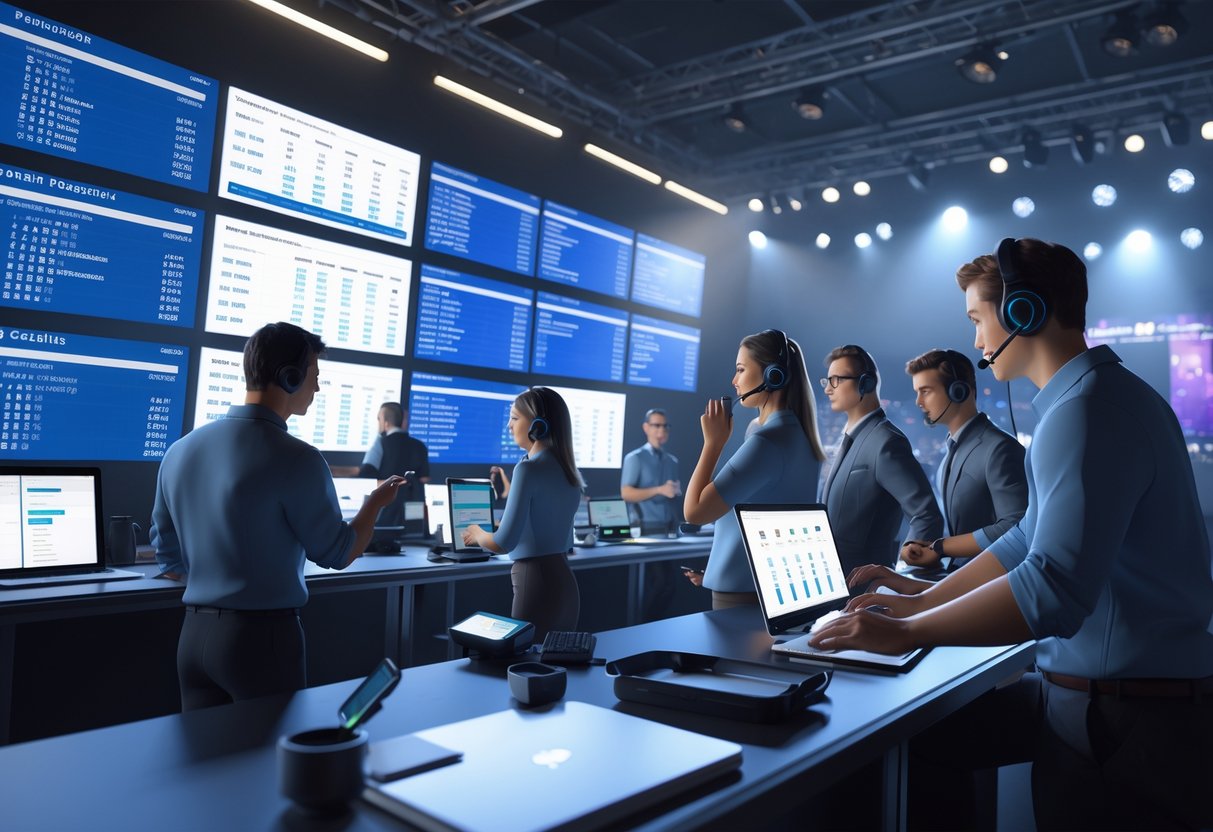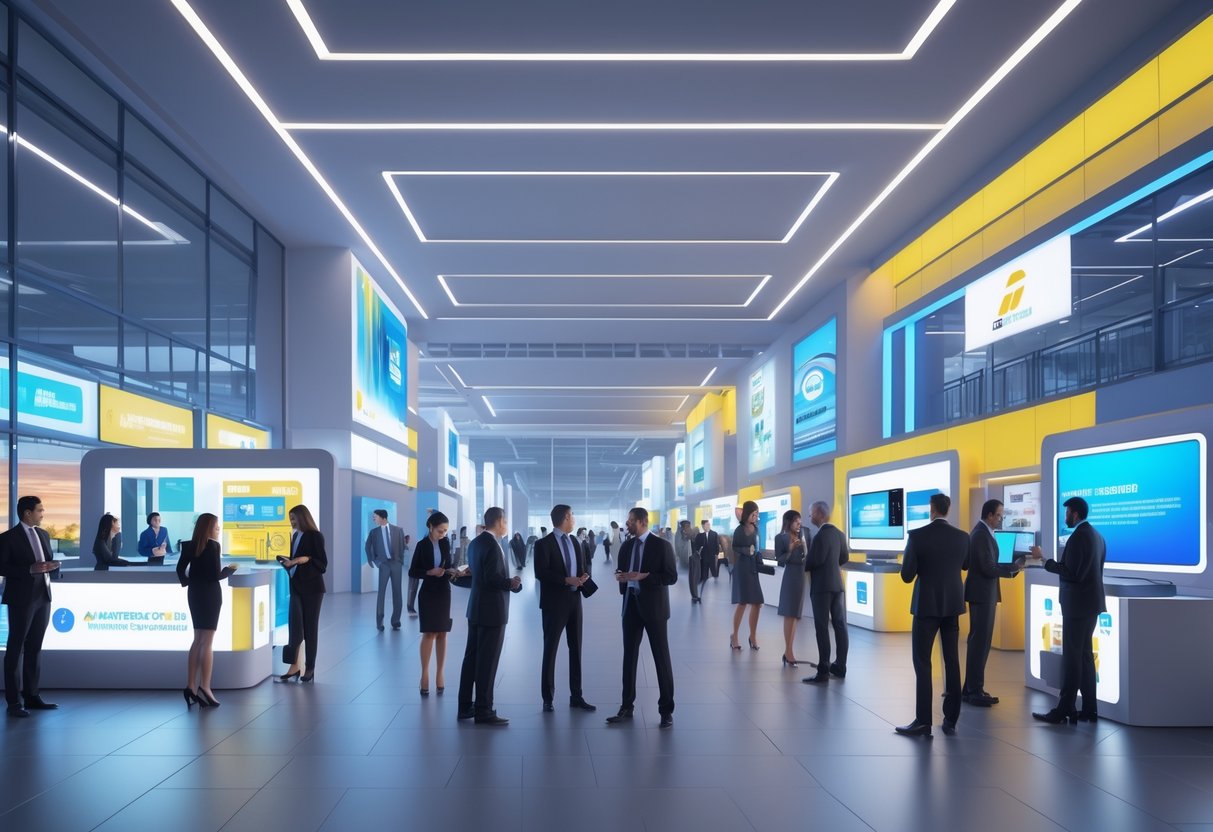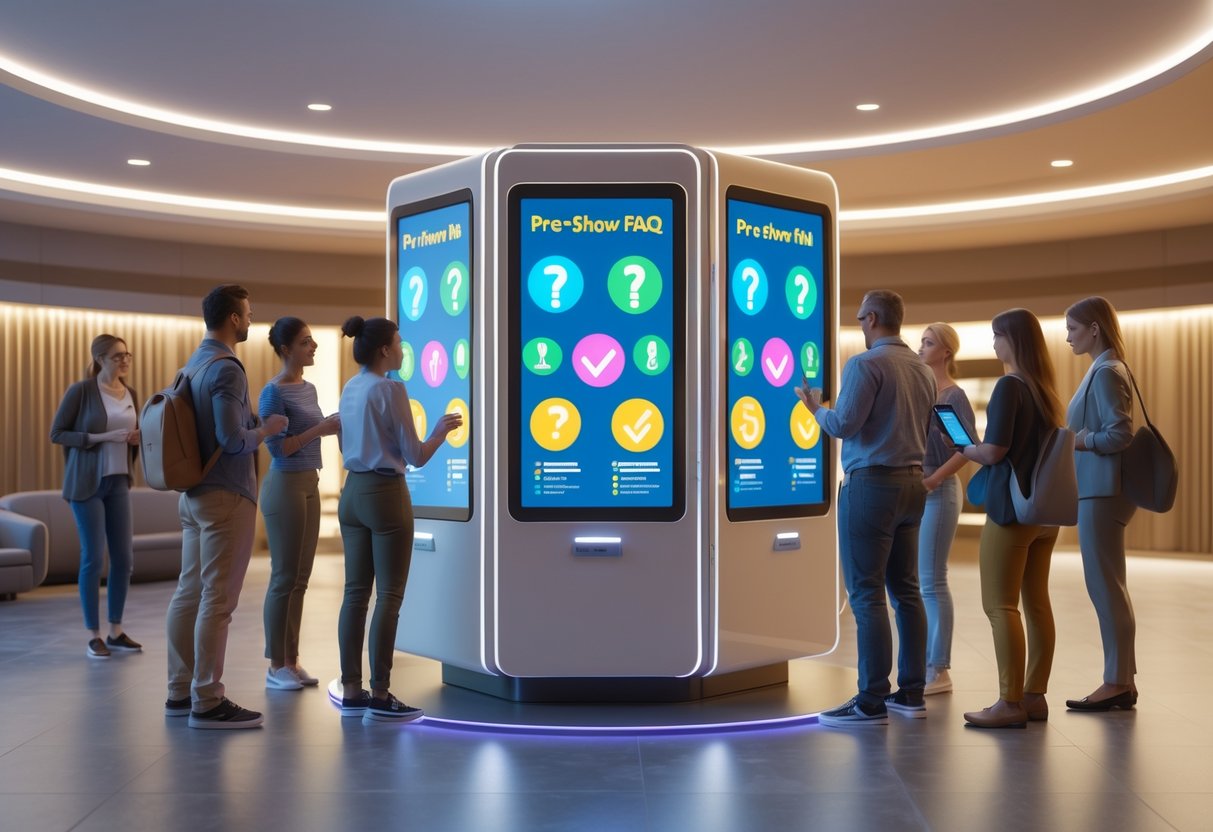Pre-Show Importance: Maximising Engagement and Results
Updated On: October 23, 2025 by Aaron Connolly
Defining Pre-Show Importance
Pre-show activities lay the groundwork for successful events. They build audience engagement and set expectations, which really matters.
These moments directly shape both how the event goes and how people feel about coming back.
Core Benefits of Pre-Show Activities
Pre-show engagement turns boring waiting time into something people actually enjoy. When folks arrive early, they often walk into awkward silence and empty seats—honestly, that just kills the mood.
Music venues, for example, thrive when they plan pre-show experiences. Just playing some background music instantly sets a vibe and helps people start chatting. That simple touch keeps people off their phones and even nudges them to buy drinks or merch.
Trade shows see clear improvements with pre-show briefings and team prep. Teams that take time to plan ahead generate about 40% more qualified leads than those who just wing it.
Key benefits include:
- Increased revenue from bar and merchandise sales
- Higher audience retention for future events
- Improved brand perception and venue reputation
- Better team performance during main events
Pre-show routines help entertainers and presenters calm their nerves. When people stick to a routine, they deliver more consistent, high-quality performances.
Pre-Show Versus In-Show Strategies
Pre-show and in-show strategies don’t serve the same purpose, and you can’t really plan them the same way. Pre-show is all about preparation and anticipation. In-show is where the main event happens.
During pre-show, we get teams ready, test equipment, and stir up excitement on social media or with interactive experiences. Most of this happens behind the scenes—audiences rarely notice the effort.
In-show strategies focus on performance and delivery. People expect smooth content, slick transitions, and a professional feel once the show starts.
Resource needs change between phases. Pre-show usually takes more planning but fewer people on the ground. In-show needs the full team and quick problem solving.
Trade show exhibitors sometimes mix up these phases. Pre-show wins come from booth design, staff training, and lead qualification systems. In-show wins rely on active selling, good demos, and relationship building.
The best events find a balance between both phases instead of just focusing on the main show.
Short-Term and Long-Term Impacts
Pre-show investment pays off quickly with better audience behaviour and higher engagement. Venues often see 15-20% higher bar sales when they add basic pre-show music or social media engagement tactics.
Short-term benefits show up right away:
- Less phone use during wait times
- More merchandise and food sales
- Happier, more energetic crowds
- Better social media content
Long-term impacts help build a venue’s reputation. People remember venues that make the pre-show experience fun and comfortable, and they’re more likely to come back.
Social media can really stretch these benefits. When people post about a great pre-show, venues get free marketing and reach new audiences without spending extra.
Trade show teams that always plan ahead get better every season. They develop systems that boost performance across events.
The biggest long-term win? Audience loyalty. Venues that nail the pre-show over and over again don’t just fill seats—they build a real community.
Building Anticipation and Audience Engagement
Great pre-show activities turn spectators into real participants. They do it with buzz, immersive experiences, and smart social media campaigns.
These approaches help people connect emotionally, which makes them more likely to stick around and come back.
Techniques to Generate Buzz
You can start building buzz with exclusive content reveals. Share behind-the-scenes videos, player interviews, or tactical breakdowns that no one else has seen.
Countdown campaigns are a hit for big tournaments. Organisers often reveal something new each day—maybe a new team, venue detail, or surprise guest.
Interactive stuff keeps the momentum going. Polls that let fans predict match winners or vote for top moments get people invested.
Limited-time offers on merch or special access create a sense of urgency. When Cloud9 dropped limited edition jerseys before their championship run, fans literally waited online for hours.
Announcing partnerships with streamers or creators also helps. These collaborations feel real when the personalities actually care about the teams or games.
Immersive Pre-Show Experiences
Both physical and digital experiences can pull fans into the action. Virtual reality demos let people see what pro players see in the heat of the moment.
Meet-and-greet sessions with players, coaches, or analysts make things personal. Fans remember those conversations for ages, and it builds real loyalty.
Interactive exhibits about gaming history, gear evolution, or tournament highlights make learning fun. Stations where visitors can try pro setups show just how much skill it takes.
Pre-tournament workshops run by coaches or analysts teach strategy basics. Attendees pick up on advanced plays during the main event and appreciate the pros even more.
Themed photo ops with trophies, team logos, or in-game backdrops give people something cool to share online.
Leveraging Social Media for Excitement
Social media turns individual hype into a group experience. Live countdown streams on Twitch or YouTube get people tuning in together and chatting before the event.
Player takeovers of official accounts give fans a peek behind the curtain. When pros share their routines or talk about pre-match jitters, it feels real and relatable.
Hashtag campaigns like #CSGO2024 or #LeagueWorlds create a shared space for fans to post and connect.
Exclusive social content gives followers something extra—maybe a sneak peek at new uniforms or a first look at the venue.
Interactive features like Twitter Spaces or Instagram polls keep people talking between big announcements. These tools turn social channels into actual conversations, not just broadcast platforms.
Pre-Show Planning Strategies
Getting ready for a trade show isn’t just about showing up. We need a game plan—clear objectives, realistic timelines, and a team that’s all on the same page.
Setting Clear Goals and KPIs
Before we even book a booth, we need to know what success means for us. If we don’t set clear goals, we can’t tell if it was all worth it.
Common trade show goals:
- Generate qualified leads
- Increase brand awareness
- Launch new products
- Build partnerships
- Conduct market research
We should make targets specific and measurable. Instead of “get more leads,” try “collect 150 qualified contacts with annual budgets over £10,000.”
Key performance indicators (KPIs) to track:
| KPI Category | Specific Metrics |
|---|---|
| Lead Generation | Number of contacts, qualification scores, conversion rates |
| Brand Awareness | Social media mentions, booth traffic, demo requests |
| Sales Impact | Pipeline value, meeting bookings, follow-up appointments |
Everyone on the team needs to get these goals. Booth staff, marketing, and sales have to work together if we want results.
Crafting a Timeline for Success
Trade show prep usually takes 3-6 months. We work backward from the event date to make sure nothing gets missed.
Timeline milestones:
90 days before: Finalise booth design, book rooms, and get marketing materials ready.
60 days before: Kick off pre-show marketing, train the team, and order promo items.
30 days before: Confirm logistics, test tech, and send last invites to prospects.
7 days before: Pack up, brief the team, and get lead capture systems ready.
We always leave buffer time for surprises. Shipping delays, last-minute design tweaks, or staff changes can throw things off.
Don’t forget these tasks:
- Test all tech and gear
- Print business cards and brochures
- Schedule meetings with prospects
- Sort out booth storage and security
Coordinating with Stakeholders
Lots of departments have to pull together for a trade show to work. We need to sync up marketing, sales, operations, and execs.
Marketing handles: Campaigns, materials, social media.
Sales takes care of: Target lists, meeting schedules, demo scripts.
Operations deals with: Logistics, shipping, booth setup, and tech.
We schedule regular check-ins, especially in the last month, to keep everyone on track.
Stakeholder checklist:
- Share contact lists between teams
- Align messaging in all materials
- Confirm who’s covering which booth shifts
- Set up lead handoff plans
We also have to keep outside partners in the loop. Booth builders, shippers, and tech providers need to know our schedule and needs.
It helps to pick one main contact person. That way, everyone gets the same info and there’s less confusion.
Designing Effective Pre-Show Marketing Campaigns
A great pre-show campaign mixes personalised email, smart social media, and useful content to get people excited before the doors even open. Each channel plays a different role in driving booth traffic and booking meetings.
Tailored Email Outreach
We start by sorting our contact lists using past event data and CRM insights. It’s the only way to send messages that actually matter to people.
Building your list:
- Data from past attendees
- CRM contacts that fit the event’s audience
- Leads who’ve engaged with us recently
- Industry folks from LinkedIn or partner networks
Writing personal messages: Emails work best when they hit on real pain points or interests. We skip the generic “come visit us” stuff.
Instead, we mention their industry challenges or even recent company news. Specific subject lines like “New solution for manufacturing efficiency – Booth 247” beat vague invites every time.
Timing matters:
- 6-8 weeks out: Save the date
- 4 weeks out: Details on the booth and meeting requests
- 1 week out: Final reminder with booth location and contact info
We track opens and replies so we can tweak our approach. Booking links make it easy for people to set up meetings with us.
Social Media Campaigns
Social platforms help us reach folks who aren’t on our email list. We focus on content that’s easy to share and gets people talking.
Platform tips: LinkedIn is great for B2B. We post behind-the-scenes shots and team spotlights.
Twitter’s perfect for real-time updates and jumping into event hashtags before they trend.
Engaging content:
- Short demo videos or sneak peeks
- Team photos during booth setup
- Countdown posts with previews
- Polls about industry topics
Hashtags: We use the official event tags and our own branded ones. Lots of attendees actually use these to plan who they’ll visit.
Pro tip: Make a simple countdown graphic you can update each week with new highlights.
Content Marketing Integration
Good content makes us look like experts before the event even starts. We create stuff that solves real problems for visitors.
Pre-event content ideas: Industry reports or trend pieces show we know our stuff. Case studies about recent wins help build trust.
Webinars or live Q&As let us chat with prospects directly. Recording these means we can use them again later.
Gated content: We offer premium resources—like whitepapers or exclusive research—in exchange for contact info. That grows our database and gives people something valuable.
Content schedule:
| Week | Content Type | Distribution Channel |
|---|---|---|
| 6-8 weeks | Industry trends report | Email + LinkedIn |
| 4 weeks | Client case study | Website + social media |
| 2 weeks | Product demo video | Email + YouTube |
| 1 week | Booth preview content | All channels |
Measuring success: We look at downloads, shares, and meeting requests from each piece. That tells us what actually works.
Heads up: Don’t make content just to tick a box. Focus on the real questions people ask during sales calls.
Target Audience Identification and Invitation

If you want the right people stopping by your esports trade show booth, you’ve got to know exactly who you’re after—and make it easy for them to find you. When you focus on smart prospect segmentation and personal outreach, you’ll pull in quality leads, not just whoever happens to wander by.
Segmenting Prospects
Let’s break our target audience into clear groups based on their esports roles. This way, our outreach actually lands.
Primary segments include:
- Pro players and coaches – Show off performance tools and training options
- Team managers and org owners – Talk up business growth and revenue ideas
- Content creators and streamers – Highlight audience engagement and monetization tools
- Tournament organisers – Push event management and broadcast tech
- Sponsors and investors – Share ROI stories and market reach data
Build separate contact lists for each group. Use LinkedIn, industry databases, and past attendee lists to dig up names.
Check out job titles, company size, and even recent social posts. A streamer with 50k followers wants different things than someone with 5k.
Quick tip: See who showed up at similar events last year—they’re probably more likely to come again.
Personalised Invitations
Nobody reads generic “visit our booth!” emails. If you tailor your message to each segment’s real problems, you’ll get replies.
For pro players: “Want to see how Team Nexus cut their reaction times by 15% last season using our new analytics?”
For sponsors: “Curious how three top brands boosted esports ROI by 40% with our measurement platform?”
Email best practices:
- Put their name or company in the subject line
- Mention a recent win or challenge of theirs right away
- Add your booth number and demo times
- Offer something exclusive or early
- Keep it short—under 100 words
Send out your first invites 6-8 weeks ahead of the show. Follow up 2-3 weeks later with new info or a fresh incentive.
Track opens and clicks by segment using Mailchimp or HubSpot.
Scheduling One-on-One Meetings
Your best prospects deserve more than a quick booth chat. When you schedule meetings ahead of time, you’re guaranteed quality face time.
Priority meeting targets:
- Major team owners or GMs
- Big sponsor brand managers
- Tournament operators with 100k+ viewers
- Investors already funding esports
Let people pick their own time slots using Calendly or something similar. Offer 15, 30, or 45-minute blocks depending on their role.
Meeting invite must-haves:
- A specific agenda or demo plan
- Clear reason their time is valuable
- A quiet meeting spot (not just the booth)
- A virtual backup if they can’t make it in person
Try to fill about 60-70% of your slots before the event. Leave a few open for surprises that pop up during the show.
Send a calendar reminder 24 hours before each meeting with your mobile number and the exact spot.
Briefing and Training for Team Readiness

Solid team briefings and training sessions help your staff rep your brand with confidence at trade shows. When everyone’s clear on messaging and products, the customer experience feels consistent.
Team Briefing Sessions
Hold your main briefing the day before the show opens. That way, the info stays fresh when it matters.
Start with the basics. Tell each team member why you chose them and what you expect. Share real goals—lead targets or sales numbers, not just “do your best.”
Make sure to cover:
- Daily schedules and shifts
- Who handles which customer enquiries
- Emergency contacts and what to do if something goes wrong
- How to capture leads
Keep it short—under two hours, or people start forgetting things.
Hand out written copies of key info. People will need to check details during busy stretches.
Take questions right away. If someone feels unsure, it’ll show when they talk to customers.
Product and Brand Knowledge Training
Train your team on every product they’ll demo or discuss. Even veterans need updates on new features or pricing.
Make simple fact sheets for each product or service. Highlight benefits, pricing, and common objections (plus how to answer them).
Focus on:
- Demo basics and main features
- Pricing and discounts
- What sets you apart from competitors
- Technical details customers always ask about
Practice tough questions. If someone doesn’t know an answer, they should know exactly who to ask for help.
Some team members might need hands-on product training. Schedule that early so they have time to get comfortable.
Update everyone on new policies or procedures. Trade shows throw curveballs you don’t see in normal business.
Establishing Consistent Messaging
Write out your main talking points so everyone’s sharing the same story about your brand. Focus on what makes you stand out from the other booths.
Key things to nail:
- A 30-second elevator pitch
- Main product benefits, plain and simple
- Pricing info and who can approve discounts
- How to follow up with interested prospects
Do some role-play during training. It helps people sound natural when things get busy.
Pick one person to handle tricky pricing talks. That way, you avoid confusion and keep deals consistent.
Remind everyone to stay focused. Friendly chat is great, but the goal is leads and sales.
Optimising Pre-Show Design and Experience

The vibe you set before your main event can make or break the mood. Your theming choices and interactive elements work together to build hype and set the tone.
Theming and Décor Choices
Your pre-show theme should fit the main event, but it needs its own twist. Choose colors and graphics that work with your main branding, not against it.
Visual consistency is huge. Stick with the same fonts, colors, and design touches on everything—entrance displays, waiting area graphics, and all the first promo materials people see.
Think about how your audience moves from the door to the event start. Place themed elements strategically to guide people and build anticipation.
Lighting changes everything. Warmer tones feel cozy for small groups. Cooler blues and whites fit tech or competitive vibes.
Quick win: Try your décor in different lighting before the event. Something that looks great in daylight might look totally different at night.
Active Interactions and Activities
Pre-show activities keep people involved instead of just waiting around. Honestly, interactive stuff beats passive entertainment every time for building real excitement.
Try these engagement tactics:
- Mini-competitions that fit your event theme
- Social media check-ins with branded hashtags
- Preview demos of what’s coming up
- Meet-and-greets with key personalities
Timing matters. Schedule the best activities right before your main event kicks off. That way, you build momentum into the show itself.
Heads up: Skip anything with a complicated setup or that could run long. Simple, repeatable activities are best for crowd flow and energy.
Put your most enthusiastic team members on pre-show interactions. They need to know both the activities and what your main event is all about.
Maximising Pre-Show ROI

If you want your pre-show investment to pay off, you need clear targets and a way to track what actually works. It’s all about setting goals you can measure and watching how people react to your outreach.
Setting Measurable Outcomes
Let’s get specific with numbers so we know if our pre-show work is worth it. Vague goals like “raise awareness” don’t help you measure success.
Lead generation targets should be concrete. Shoot for 200 booth visits, 50 qualified leads, or 30 demo bookings. These are numbers you can actually track.
Cost per lead is key for efficiency. Spend £5,000 on pre-show marketing and want 100 leads? Your target is £50 per lead.
Set channel-specific goals:
- Email: 15% open rate, 3% click-through
- Social: 500 impressions, 50 engagements per post
- Direct mail: 8% response
- Landing pages: 12% conversion
Booth traffic matters too. Maybe you want 40 good conversations a day or 25% of visitors leaving their info.
Tie revenue goals to leads. If deals average £15,000 and you close 20% of qualified leads, 50 prospects could mean £150,000 in potential revenue.
Tracking Engagement Metrics
We need to track how people interact with our pre-show content to see what’s working. Different metrics tell us different things about our trade show marketing.
Email stats show early interest. Watch open rates, clicks, and replies. Low opens? Your subject line needs work. Lots of clicks but few booth visits? Maybe your follow-up is weak.
Website analytics dig deeper. Track page visits, time spent, and form fills. Use tracking codes for trade show pages so you know exactly where the traffic comes from.
Social engagement means likes, shares, comments, and saves. Comments usually mean more interest than just likes. Track hashtags and mentions tied to your trade show presence.
Add UTM parameters to every link. That way, you’ll see if LinkedIn outperforms Twitter or if email beats social.
Registration tracking for demos or meetings shows real commitment. Someone booking a slot is way more valuable than someone who just grabs a brochure.
Keep a simple tracking spreadsheet and update it weekly. Add metrics like email subscribers gained, new social followers, and website visitors from your campaigns.
Technology Utilisation in Pre-Show Activities

Modern tech totally changes how we connect with people before an event. Digital platforms and mobile tools let us build personal experiences, hype up the show, and collect useful data on attendees.
Digital Tools for Attendee Engagement
AI-powered tools help us spot high-intent attendees before the doors even open. We can look at behavioural data and send targeted, personal messages.
Automated calendar schedulers make booking meetings painless. Instead of scrambling last minute, we can fill the calendar weeks ahead.
Email sequencing gets a boost from AI personalization. Using a pattern like the Fibonacci sequence (1, 2, 3, 5, 8 days) helps you space out messages naturally—no spamming.
We start collecting real-time data before we even get to the venue. Badge scans and CRM notes help us prep for specific visitors.
Social media integration stretches our pre-show reach. We can tie online engagement directly to booth visits later on.
People love interactive stuff—polls, quizzes, virtual previews. These not only build excitement, but also give us useful info about attendee preferences. That data shapes how we approach them at the event.
Augmented Reality and Mobile Integration
Mobile apps make pre-show experiences feel seamless and carry that energy right into live events. Attendees can check out booth layouts, schedule meetings, and grab exclusive content with just a few taps.
AR previews let potential visitors get a taste of what we offer before they even show up. Product demos on smartphones help people feel familiar and maybe even a little more interested.
Push notifications sent at just the right moment keep us in people’s minds. When prospects arrive at venues, location-based triggers can spring into action.
QR codes connect physical and digital worlds. We can link print materials to personalized landing pages or booking systems—pretty handy.
When we share virtual reality experiences online, people start talking. Early adopters love to share, and that buzz spreads our reach without much extra effort.
We can integrate with business tools to keep data flowing smoothly. CRM systems track pre-show interactions, so sales teams get a complete picture of each attendee.
Managing Pre-Show Logistics

Logistics management really kicks off months before your trade show. Booth preparation and coordinating your materials and promotional items are your main focus.
Booth Preparation Considerations
Start planning your booth setup at least 8 to 12 weeks ahead. Write out a checklist that covers every detail of your display.
Essential booth elements to plan:
- Display materials and graphics
- Furniture and seating
- Audio-visual equipment
- Storage solutions
- Staff uniforms and name badges
Confirm your booth dimensions with the venue as early as possible. Exhibitors often run into last-minute headaches when things don’t fit the space.
Talk with your venue about setup times and any restrictions. Some places only allow setup at certain hours or require union labor for specific tasks.
Test all your tech before shipping it out. Pack some backup cables, adapters, and maybe a few extra extension leads. Venue WiFi can be spotty, so bring a mobile hotspot if you need reliable internet.
Draw up a floor plan showing where everything goes. This saves time during setup and helps your team stay organized.
Coordinating Materials and Giveaways
Order your promotional materials 6 to 8 weeks before the show. That way, you have time to fix any printing mistakes or quality issues.
Key materials to coordinate:
- Business cards and brochures
- Branded swag
- Product samples
- Lead capture forms
- Prize draw materials
Ship your stuff so it arrives 1 to 2 days before you start setting up. If you can, use the venue’s recommended shippers—they know the ropes.
Pack promo items separately from booth displays. You’ll find it easier to grab them during the show, and they’re less likely to get damaged.
Bring enough materials for 2 to 3 times your target number of leads. It’s better to have a little extra than to run out.
Make an inventory list for everything. Note quantities, storage spots, and who’s in charge of what. That way, nothing gets lost in the chaos.
Enhancing Brand Perception Pre-Show

Building a strong brand image before an esports event isn’t just about planning—it’s about smart, honest messaging. You want to give fans early access to what makes your brand stand out.
Compelling Brand Messaging
Your pre-show messaging needs to cut through the noise. Esports fans scroll through hundreds of posts every day on social media, Discord, and streaming apps.
Focus on three core messages. First, show what makes your team or organization unique. Second, talk about the values that connect you with the esports community. Third, highlight your competitive advantages.
Effective messaging channels include:
- Twitter threads with behind-the-scenes content
- Instagram stories from training sessions
- TikTok videos featuring player personalities
- Discord announcements for your community
Keep your tone real. Esports fans spot corporate speak a mile away. They care more about honesty than polish.
Gaming expert James Connolly points out that top esports brands “speak like they’re part of the community, not outsiders trying to sell something.”
Early Access to Merchandise and Promotions
Giving fans pre-show exclusives actually gets them excited. This approach works especially well in esports, where community loyalty runs deep.
Popular pre-show offers include:
- Limited edition team jerseys
- Early bird ticket discounts
- Exclusive in-game items or skins
- Meet-and-greets with players
Try launching these offers 2 to 4 weeks before big tournaments. That’s enough time to build anticipation without overwhelming fans.
Make your offers truly exclusive. Fans love being first in line for merchandise that not everyone gets. Think about special colors or designs just for pre-show sales.
Quick win: Team up with game developers to offer exclusive in-game content. Digital items often get more buzz than physical merch, and they’re usually cheaper to produce.
Frequently Asked Questions

Pre-show planning brings up a lot of the same questions—about music, audience engagement, and keeping everything on track. These details can make a big difference once the doors open.
What are the benefits of setting the right mood with pre-show music?
Pre-show music creates an instant emotional connection with your audience. It sets the event’s energy and hints at what’s coming.
The right music calms pre-event nerves and helps people relax in their seats. It also covers up awkward silences as folks settle in.
Music can act as a subtle countdown. You can change the volume or tempo to signal when things are about to kick off.
For esports, familiar game soundtracks or electronic music usually hit the mark. They match your audience’s interests and build hype for competitive gaming.
How does the pre-show announcement contribute to the audience’s experience?
A good pre-show announcement sets expectations right from the start. It tells people what to expect, when things are happening, and how to join in.
These announcements also cover practical stuff like phone policies and emergency exits. They introduce key speakers or players, so people know who to watch for.
For virtual events, announcements explain the tech side and how to interact. This keeps confusion low and engagement high.
Pre-show announcements reinforce your brand, too. They’re a chance to thank sponsors, mention future events, and set a professional vibe.
Could you suggest some effective ways to engage an audience before the main event begins?
Interactive polls are a great way to warm up the crowd. Ask simple questions about your event or get some quick demographic info.
Social media integration helps people stay engaged with their devices, instead of just scrolling aimlessly. Set up event hashtags and encourage folks to share what they’re excited about.
Live Q&A sessions before the main event let you spot what the audience is interested in. You can tweak your content to match.
For esports, show highlight reels from past tournaments. Put up player stats or team rankings to get people talking about upcoming matches.
Contest giveaways bring instant energy. Simple prize draws for branded swag or gaming gear always get attention.
What are the key elements to consider when scripting a pre-show announcement?
Keep your announcement short and focused. People want the essentials, not a long backstory.
Start with a warm welcome. Thank everyone for showing up and give a quick note about what makes this event special.
Share the exact timing for when the main event starts. Be specific—give minute counts, not just “soon.”
Cover housekeeping early. Mention phone rules, bathroom locations, and any safety info the venue requires.
Wrap up with a little tease about your main speakers or entertainment. Build excitement without spoiling the surprises.
In what ways can pre-show activities add value to the overall event?
Pre-show activities make your event feel bigger than just the main presentation. Attendees get more for their time and money.
These activities help people connect over shared interests before things get official. It’s a good way to build community.
Educational pre-show content can give background that makes the main event easier to follow. This is super helpful for technical or niche topics.
In esports, pre-show interviews with players or analysts add that insider edge. Behind-the-scenes content helps casual viewers understand what’s really going on.
Networking during pre-show time can lead to unexpected business connections. A lot of attendees value these informal chats just as much as the main event.
How important is it to tailor pre-show content to fit the theme of the main event?
When you keep your theme consistent, people notice. Everything just feels more polished and intentional. If your pre-show content doesn’t match, it can really throw folks off and make them question what your event is all about.
The pre-show sets the vibe for what’s coming. Play high-energy music and you’re basically telling everyone to expect something lively. Go with mellow tunes or visuals, and you hint at a more reflective or thoughtful event.
Themed pre-show content lets you sneak in your key messages before things even officially start. It’s a clever way to help people remember what matters most and get them more involved.
If you’re running an esports event, don’t go generic. Lean into the specific game. For example, if it’s League of Legends, use that game’s music and visuals—don’t just toss in random gaming stuff.
When you stick to a consistent theme, your brand stands out more. People tend to remember those cohesive, well-put-together experiences way better than ones that feel all over the place.

